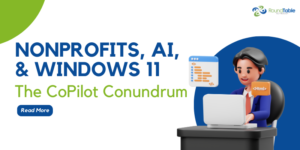When it comes to cybersecurity, there are a lot of dangers that organizations need to be aware of. For nonprofits, bring-your-own-device (BYOD) can be especially risky.
In this blog post, we will discuss three of the biggest dangers of BYOD for nonprofits: data security risks, problematic legal issues, and compliance difficulties. We will also offer some tips on how to mitigate these risks.
What is a BYOD policy and why are they risky for nonprofits
While allowing BYOD some conveniences and cost savings, nonprofit organizations may wish to take extra precautions to ensure the confidentiality of client data.
This however can be quite a risky venture for nonprofits, as bringing your own device introduces some new security risks.
Hackers and scammers are quick to exploit any weaknesses in computer systems; ] since personal devices may not be as secure as their office counterparts, they can leave nonprofits more vulnerable to compromised data and privacy breaches.
Additionally, workers who use their personal devices to access confidential or proprietary company data may be less likely to backup that information or apply recommended security measures, making the nonprofit even more at risk of losing or exposing sensitive information
Three dangers of BYOD use for nonprofits
It is wise to be mindful of three dangers posed by BYOD use: data security risks, legal issues, and compliance difficulties.
Without proper safeguards in place, sensitive data stored on employees’ personal or home computers can become vulnerable to cyberattacks, putting the entire organization at risk.
Furthermore, because devices used for business purposes may hold both personal and distributable information, a legal grey area may arise when determining who is liable for misuse or unauthorized distribution of that information
A bring-your-own-device (BYOD) policy is an employer or organization’s rule allowing employees to use their personal devices for business purposes. .
Without implementing specific BYOD protocols or rules for device use within the organization’s network infrastructure–such as restricting employee access to certain websites or files–the nonprofit could be subject to hefty penalties for noncompliance with industry standards.
That’s not to say that you can’t make a BYOD policy work, it’s just important that nonprofits are aware of the dangers before adopting one to ensure a secure and compliant work environment.
How to mitigate the risks of BYOD Use
To help mitigate the potential damage, organizations should look for ways to monitor and enforce acceptable device usage.
This could include setting up specific guidelines (a policy) for what types of devices can be used to access organizational data, and providing employees with additional cybersecurity education so they are aware of the dangers associated with connecting their personal devices to corporate networks. Organizations should also provide strong encryption techniques to safeguard all device data and consider regular security scans of employee connected devices.
Having a clear policy in place which clearly explains to personnel the risks associated with bringing their own devices into a workplace environment is essential – this ensures everyone is aware of the potential consequences of unsecured devices and how best to protect themselves and your organization’s data.
Final thoughts on cybersecurity awareness for nonprofits
Cybersecurity awareness is an important topic for nonprofits, and not just as it pertains to BYOD. As any organization that handles sensitive information, from the financials of donors to constituent information, there needs to be constant vigilance and education in order for data to be protected.
Nonprofits are especially vulnerable targets for cyberattacks since their resources may be limited when it comes to developing a strong cybersecurity platform. In fact, according to a report from Netdilligence, out of eighteen sectors listed, nonprofits are the 6th most likely sector to be targeted by cyber criminals.
With that in mind, nonprofits must prioritize that all staff members are properly educated(and get buy-in from them) on how to handle sensitive information and stay up-to-date on the latest cybersecurity technologies and trends. Making sure that there are robust practices in place to ensure that gaps in employee training are addressed can go a long way in providing protection against malicious acts online.
When all stakeholders are made aware of the importance of cybersecurity within an organization, it creates the culture needed to support a safe digital environment.
A great way to start getting your staff up to date on the best ways they can protect themselves and your organization is to have an organization-wide cybersecurity awareness training at least once per year.
Sign up for our Best Free One-Hour
Cybersecurity Awareness Training Ever!




No comment yet, add your voice below!